This is the Revell 03084 kit in 1/35 scale, of the ‘Russian Tank Destroyer, SU-100’.
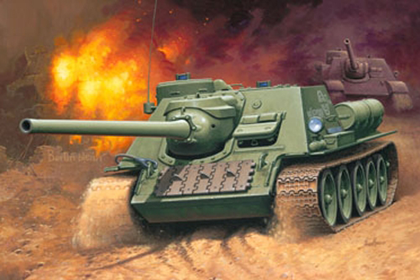
This is the Revell 03084 kit in 1/35 scale, of the ‘Russian Tank Destroyer, SU-100’.

This is the Revell 03076 kit in 1/35 scale, of the ‘Russian BM-13, Katiusha’.
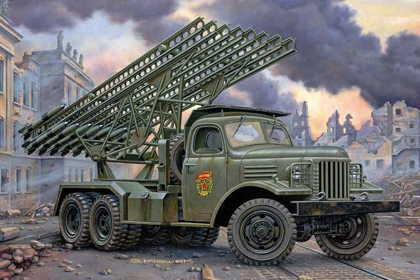
Katyusha multiple rocket launchers are a type of rocket artillery first built and fielded by the Soviet Union in World War II. Multiple rocket launchers such as these deliver a devastating amount of explosives to a target area more quickly than conventional artillery, but with lower accuracy and requiring a longer time to reload. They are fragile compared to artillery guns, but are inexpensive and easy to produce.
Katyushas of World War II, the first self-propelled artillery mass-produced by the Soviet Union, were usually mounted on trucks. This mobility gave the Katyusha (and other self-propelled artillery) another advantage: being able to deliver a large blow all at once, and then move before being located and attacked with counter-battery fire.
This is the Tamiya 35 205 kit in 1/35 scale, of the ‘German Infantry Equipment set B – Mid/Late’.
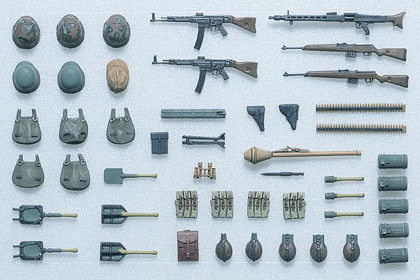
This is the Tamiya 35 204 kit in 1/35 scale, of the ‘German Infantry Equipment set A – Early/Mid’.
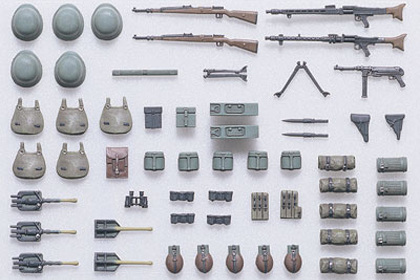
This is the Dragon 6096 kit in 1/35 scale, of the ‘Russian Tank Destroyer, SU-85M’.
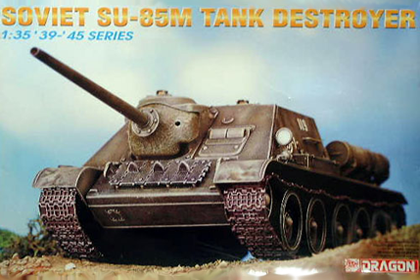
There were two versions: the basic SU-85 had a fixed commander’s cupola with a rotating periscope and three vision blocks; the improved SU-85M had the same casemate as the SU-100, with a commander’s cupola as used on the T-34-85.
This is the Tamiya 35 066-1600 kit in 1/35 scale, of the ‘Russian Heavy Tank, KV-1 Type C’.
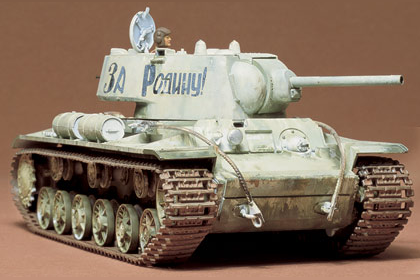
When first introduced in late 1930’s, the KVI was no doubt one of the most powerful tanks in the world, and a complete secret. It was built to be completely “bulletproof”, and was shot proof against the 37mm Anti-Tank Gun with it’s thick 100mm armor.
In the B-model, armor was increased an additional 25-35mm. The C-model used a cast turret, replacing the old plated one to increase protection.
This heavy tank, weighing around 45 tons with crew of five, was armed with 76.2mm main gun and two MGs. The armament was considered heavy for 1940, but by 1943 the main gun lacked punching power against new Panthers and Tigers. Its weight caused constant trouble with the transmission. As weight increased due to additional armor, the engine power was not increased. This caused successive models to become slower.
This is the Academy 13236 kit in 1/35 scale, of the ‘German Flakpanzer IV, Wirbelwind’.
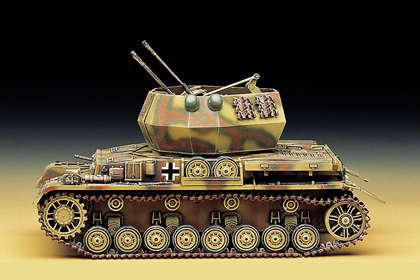
This is the Trumpeter 00209 kit in 1/35 scale, of the ‘German Mörser Karl-Gerat 040/041 on railway transport carrier’.
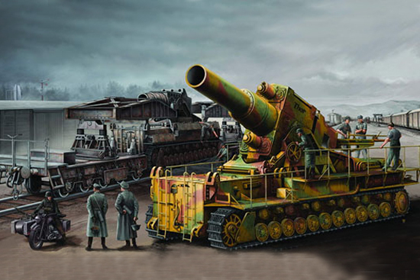
At a conference with Hitler in March 1943, it was stated that the first 54cm Gerät 041 would be delivered by June 1943, and the third, by mid-August. The 60cm and 54cm barrels appear to have been interchanged as required. In 1945, US forces captured vehicle II with a 60cm, and vehicle V with a 54cm. The prototype chassis, built in 1939, had eight road wheels with external swing arms. production Karl had eleven road wheels.
Ammunition was transported in a tracked Munitionsschlepper converted from the Pz.Kpfw.IV, four rounds in each Schlepper. For the 60cm Gerät 040, the s Be Granate weighed 2.117 tons and the Ie Be Granate, 1.70 tons; in this case of the 54cm Gerät 041, 1.58 tons and 1.25 tons respectively. Maximum rate of the fire was 6 rph (rounds per hour ). Guns I-IV went to the Russian Front in July 1941 with the 628th schwere Artillerie Abteilung.
They saw action at various sites, including Lemburg in that year. The best known action was against Sevastopol in 1942. Later, four guns were issued to the 833rd schwere Artillerie Abteilung (mot). These guns had the names Adam, Eve (1st Batt.) and Thor, Odin (2nd Batt.) The names for guns V and VI were Loki and Ziu.
This is the Italieri 6427 kit in 1/35 scale, of the ‘Russian Medium Tank, T-55’.
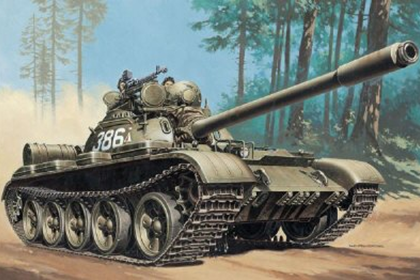
The T-54 entered full production in 1947 and became the main tank for armored units of the Soviet Army, armies of the Warsaw Pact countries, and others. T-54s and T-55s were involved in many of the world’s armed conflicts during the late 20th and early 21st century.
This is the Tamiya 35 186-700 kit in 1/35 scale, of the ‘German Fuel Drum set’.
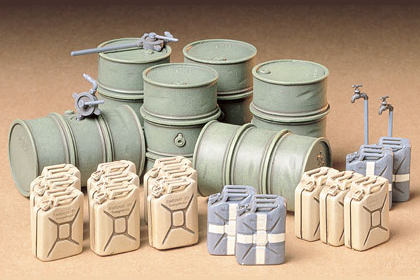
This is the Tamiya 35 291-3000 kit in 1/35 scale, of the ‘German 3 Ton 4×2 Cargo Truck’.
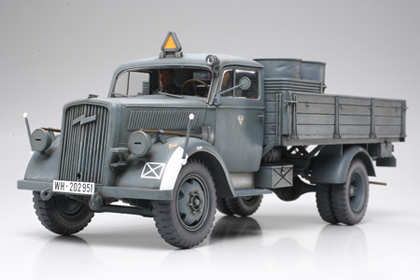
Ideal choice for German Army – The German army in WWII used a wide variety of wheeled vehicles as part of their overall strategy of fast mechanized warfare. Among the most widely used was the 3 ton 4×2 Cargo Truck, a truck design that was first produced in the 1930s. From 1937 to 1944, over 78,000 medium 3 ton 4×2 Cargo Trucks were produced and they became the most recognized German army truck in WWII.
Featuring a dependable 6-cylinder gasoline engine, the 3 ton 4×2 Cargo Truck could take on a very large payload disproportionate to its size. It also featured a durable rear wheel-drive chassis with superior off-road handling and a large cargo area, which enabled superb load-carrying capacity.
They proved to be not only extremely reliable, but also very versatile, and were employed in a wide variety of roles, including fuel truck, ambulance, radio truck, as well as general-purpose cargo truck and was until the end of war used to transport troops and supplies on all fronts.